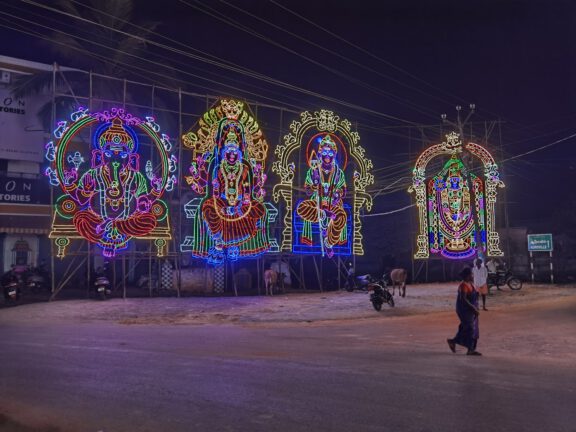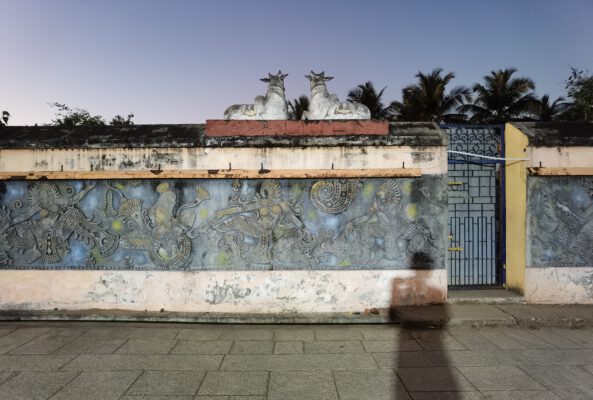Hhere in Auroville, a play was recently taken off the program by the hosts of the Bharat Nivas. The reason given was that some in the community had taken offense even before it was performed. This raises questions. What is art allowed to do, when is a ban justified? Linked to this is, of course, the question of what is the role of art, i.e. what should art do? The question invites us to think about the role of art in general, here in India and in the West. And because this very fundamental question extends not only across the Indo-European region, but also covers a whole range of different cultures, I would also like to give it a temporal dimension.
Let's start at the beginning, e.g. with the Classical Greeks. On the one hand, there is the question of beauty (form, function, and/or proportion), but on the other hand there is also the question of the role of art within philosophy (techne, mimisis, aisthesis). At its core, this constellation of concepts is about the relationship of the subject to the outside world as an object. How do people perceive the world, how and why do we imitate the world, e.g. in the theater or in sculptures? What techniques, what tools do we use to shape the world, to give it a function, or to work out beautiful, i.e. mathematical proportions? In other words, it is about the relationship between man and his environment in a formative relationship.
Art is created, brought forth, is the expression of a subject that shapes the world of objects. In Western art, we see the artist and his vision. Despite all the rapid developments in European art history, this has not fundamentally changed to this day.
'Indian' art is quite different. Classical Indian art expresses feelings that are universal. Feelings of spirituality, human emotions, forces at work in the world. The artist is secondary to the work of art, actually unimportant, because only what is expressed in the work of art counts, because it is a reflection of the forces at work in the cosmos. The artist has merely made them visible. And this is where the misunderstanding arises that the art of India is largely similar to the art of the European Middle Ages, as there was no artist there like in antiquity or the Renaissance. What is the difference?
Textuality and interpretation
There is an important difference. The Western eye, or ear, the Western mind, looks for what can be interpreted in the work of art. This can be an intrinsic quality such as beauty, or a technical mastery, an iconographic reference, the genius of the artist, an object that is part of a discourse, an object of reflection, or quite 'simply' an image, a representation or a depiction. The list could go on and on. Essentially, however, it is always a question of interpretation. If a work of art is the subject of a differentiated interpretation, then it is considered a successful, great work of art. If it is an object that triggers a response, it is suspected of being 'mere' design, handicraft or kitsch.
In this way, the West has produced a cultural landscape based on interpretation. And interpretation is ultimately a critical analysis in the medium of language, i.e. it is textual. The encounter with art is one of reflection on art. Contemplation, which is also a recurring theme in Western discourses on art theory, is a preliminary stage of this reflection. Contemplation is reflected upon and expressed afterwards and thus robbed of its power.
The sublime
The aesthetic experience that eludes these discursive tendencies enters the realm of the sublime, the sublime, a realm of secular transcendence, i.e. the limits of language. For the limit of the textual is also part of the discourse, only as a demarcation and reference to the unspeakable. However, Western art theory usually leaves it at this reference. To continue talking about what cannot be said would be paradoxical. And so the viewer in the West goes to art temples, museums and galleries, churches and archaeological sites, urban places or nature in order to interpret what is presented there, or to fall silent before the unspeakable.
In traditions based on monotheistic religions, art therefore takes on the role of narrative, i.e. the story of the religion is told. The spiritual power of art is subject to an increasing process of abstraction. Art is becoming increasingly secular, materialistic, capitalistic, whereas religion is becoming increasingly strikingly transcendent. Religion refers to an afterlife where personal life finds a continuation. Of course, this hereafter cannot be experienced, cannot be expressed, but at the same time it is conceived as a reflection of our reality, albeit idealized.
There are therefore different forms of representations of reality. And so art is robbed of its power of wonder. It becomes a 'narrative culture', a culture of representation and the subject of various cultural techniques; it becomes part of the logos. Yet there is a clear desire to approach the unspeakable, the sublime. For this unspeakable does not elude experience, it just cannot be grasped by the rational mind. The problem lies in the fact that the rational mind follows the logic of a systematization of the world through the Logos. In the West, the idea prevails that the Logos can explain the world and that other ways of accessing the world are inferior to this Logos and must first be systematized by it: this applies, for example, to intuition, feeling, consciousness, the experience of the self and the experience of that which transcends the self. These phenomena are understood as unenlightened in Western culture. And so a desire for the sublime arises, which is demonized as unenlightened. Culture suppresses. For Freud, culture is sublimated sexuality. There is something in the description for the West.
Brahman
In Indian art, it seems to be the other way around. Indian art produces something that eludes language. Tradition speaks of rasa1a vibration in perception that is often translated as taste, but not in the sense of a good taste in art, but in the sense of a quality that is evoked by a work of art. This vibration in the artwork creates a vibration in the viewer and connects the inner self of the viewer with the quality evoked in the artwork, which in turn is testimony to a force behind the superficial reality.
In Indian philosophy, the basic idea prevails that Brahman, the supreme being that encompasses everything, wants to experience itself. It is only for this reason that Brahman emerges from perfect existence and unfolds in the physical world. The cycle of the world, the world soul, the individual consciousness, the universal forces, all this is Brahman experiencing itself. Brahman is therefore inconceivable for us, we are part of Brahman, Brahman is within us, everything is Brahman. The role of art here is to represent some of these forces. Art makes the viewer wonder. A quality that is expressed in the work of art is captured as rasa. It cannot be expressed directly in language. The statue of a god is an expression of a quality, a force in the cosmos that has become tangible (tangible, palpable). The fact that the viewer and the artist evoke a rasa through the work of art means that this perception, the consciousness, the experience, the vibration of consciousness there is.
Existence
What does Dasein mean here? Existence should not be understood here in a dualistic sense, as if a quality in a work of art is perceived by a viewer and this quality is present in the work of art. Rather, existence here means that a force of the cosmos, a part of Brahman, has unfolded and become visible. Visible not in the sense that a viewer sees something in a work of art, but that a force shows itself in a work of art and evokes a rasa in the viewer that allows him to participate in the force. This is why the statues of the gods in India are animated. The gods are in them. When the powers are appeased through worship - puja - then they are there. Devotion to the universal principle is bhakti, it also defines an attitude in the relationship between the ritual object and the worshippers. The observer does not interpret or judge an external object, but the soul surrenders to the gods. This surrender is facilitated by a medium, a work of art.
In India, art is still part of the cosmic cycle, part of Brahman, it is animated, just as the whole cosmos is animated. Temples, statues, poems, dance, music are part of the cosmos, part of the cosmic forces, they are part of Brahman, and they enable the viewer to see aspects of Brahman more clearly, more vividly, more alive. Art means being able to wonder, to taste what is otherwise difficult to find - Rasa2. Brahman is present in Indian art. The existence of art is the presence of cosmic forces, gods as they say here.
Back to the initial question: What is art allowed to do?
I now ask myself what these considerations mean for the freedom of expression in art? In the Western tradition, it is self-evident that the discursive nature of art not only allows for a culture of debate, but also generates and cultivates it. Criticism, disagreement, satire and censorship are part of the cultural industry, and exploring the boundaries is part of the practice. But what is the role of satire in Indian art, for example? What aspect of Brahman is realized here? Can't everything be shown? Even the gods laugh and cry, are angry or heroic.
I have a question here: in the West, art is often part of political culture. Politics is brought onto the stage and art intervenes in society and politics. In the 20th century, art was called upon to take its responsibility in society more seriously and to participate in political discourse. But does this also apply to art in India, a subcontinent torn by colonialism? India, with its many languages, cultures and religions, is such a colorful, tolerant country that feeds on a connection to spirituality in whatever form. To date, the world's largest democracy has largely granted freedom of expression. But when I talk to cultural representatives here, many point to the tradition of the role of art in promoting spiritual growth. Here in the country, I rarely hear that art has a political mission.
At the same time, however, many critical voices were heard at the Kochi Biennale, for example. Much of the art there took a very clear political stance on current issues such as the climate crisis, equal rights, the persecution of minorities, exploitation and corruption. I was very familiar with the artistic language of these positions, which was based on Western forms of expression.
These two worlds collide in India. The triumph of capitalism and its secular, i.e. materialistic structure does not stop at India. It remains to be seen whether the instruments of this culture industry will help to save the victims of this very culture industry. Traditionalists are trying to protect themselves from these colonial structures by rejecting modernity. This is perceived in the West as backward and conservative.
The culture war is also in full swing here in Auroville. If there is currently talk of a new global order in 2023, it is also about this culture war.
___
1 Rasa comes from the dramatic arts, poetry, dance and theater. But I would like to understand rasa a little more broadly here.
2 In poetry, the basis of theater and dance, the rasas are well defined: The four primary rasas are: Love/Eroticism (Śṛngāram), Heroism (Vīram), Anger (Raudram) and Disgust (Bībhatsam). Derived from them are: Humor (Hāsyam) from love (Śṛngāram), compassion and pathos (Kāruṇyam) from anger (Raudram), wonder and magic (Adbhutam) from heroism (Vīram) and fear (Bhayānakam) from disgust (Bībhatsam). Over thousands of years, a very differentiated system has developed as to how different aspects of the human psyche can be represented and to which gods they correlate.







